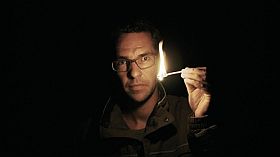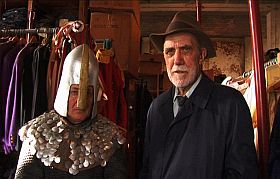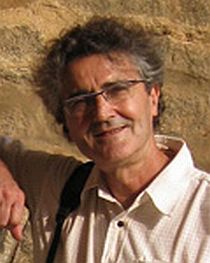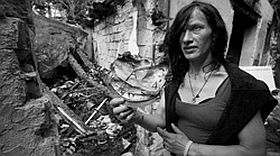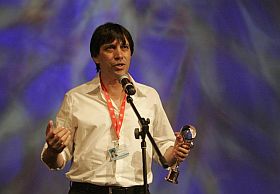


Jørgen Leth: Det erotiske menneske

Titlen leder i første omgang på vildspor. Den leder mænd og nok især kvinder på vildspor. Foromtale og stills hjælper til: man forventer pik og patter. Og så er det sådan, at kun mændene får deres syn for sagn, ovenikøbet i en ren overdådighed af bare bryster, mens kvinderne tilsyneladende snydes, der er ikke antydning af pik i den film, ikke skyggen af en tilsvarende fremvisning. Imidlertid, efter den første skuffelse, indser kvinderne, at alle disse fraværende smukke og veludstyrede mænd i filmen lever og ses i de utallige nærværende kvinders blik, instrueret som kvinderne er – vel at mærke inde i filmens dialog – til at samle deres tanker og koncentration om den dejligste mand i deres fortid. Hver deres dejligste mand. Det er ansporet af denne erindring, synlig i blikkene mod kameraet, at brystvorterne erigerer.
Psykologens kommentar er tilsvarende opmærksom. Det ses, at Jørgen Leth både som filmens hovedperson og som dens instruktør er begejstret for netop de kvinder, som er begejstret for ham. Som menneske søger han bekræftelse hos disse kvinder. Han lever den usikre eksistentielle situation, et kærlighedstab engang, og kompenserer ved en midlertidig situation af lykke, kvindens accept i som regel korte, enkelte gange lidt længere, øjeblikke af værdsathed. Føler sig begæret, er begæret. Som et erotisk menneske. Denne udsathed er det erotiske menneskes virkelighed.
I en overvældende ærlighed og præcis u-selvhøjtidelighed, befriende muntert ind imellem, lægger filmen disse kort på bordet. Det måtte jo komme, stikket. (Nej, det er ikke det sidste). I tekst efter tekst, film efter film havde Leth ved sine udspil denne årrække fået os til at ane, hvad der sad på hånden. Jørgen Leth lader som om, intet er sket i mellemtiden, han placerer ikke sin film i den offentlige debat, i sladderens verden af karaktermord, men fortsætter det arbejde, som hele tiden har ligget i det poetiske værk. Opfylder kravene her: der er dette at gøre, og så dette. Og han bliver ikke klogere, vi bliver ikke klogere, men eftersøgningen fortsætter.
Udenrigskorrespondenten fandt ikke kvinden igen, men smed skjorten og gav sig til at danse med drengene, stemmen fandt ikke Traberg, men vi så ham og og forstod ham måske, de to sammenklippede filmhold fandt ikke kærligheden, men lavede umistelige notater, fandt antropologen Malinowskis verden, og hans bog blev herefter selve bogen for instruktøren og ekspeditionslederen. Det fortalte han forleden på et seminar på universitetet i Aarhus, eftersøgningen var fortsat, og den nye film var omsider færdig.
Det erotiske menneske griber igen og igen tilbage i det samlede værk. Men gentagelsen er naturnødvendigt ny hver gang. Det gentagne tegner sig i nyt lys i nye omgivelser. Den haitianske digters tekst opstod, som hun sad på balkonen på hotellet i Haiti, uden titel (1996), den udfoldede sig i vemodigt kommenterende omgivelser i bogen Historier fra Haiti (2000) og fremtræder nu i tre forskellige variationer læst af andre kvinder, forbundet med andre kvinder, lagt ind i andre levede liv.
Optagelserne fra castingen, nærbilledet af håndens notat med to stjerner, ind imellem en ekstra stjerne i parentes, må være en nøglescene: ingen af de mulige medvirkende kasseres, alle har deres skønhed, alle har deres historie, og filmens generøsitet kan indlemme dem alle i en sekvens af total forståelse og accept. Det er også det billede, Per Kirkeby har valgt til sin plakat. Men spejlscenen med samtalen med kæresten Dorothie kombineret med optagelsen fra dengang af Dorothies ansigt under et af samlejerne i deres deres liv sammen, er selve omdrejningspunktet. Her dementeres alle falske rygter uden videre og uden at forstyrre det nye mødes fortrolighed, her bekræftes den pagt, de havde, her understreges deres fælles forståelse af deres relations grundlag. Sådan. Og forståelsen af de mange kvinders blikkes fokusering af hver deres mand i fortiden samles i Dorothies blik den bestemte dag, netop det øjeblik, da netop han var i hendes fokus, var hendes mand.
Jørgen Leth: Det erotiske menneske, Danmark 2010, 85 min. Manuskript: Jørgen Leth, fotografi: Dan Holmberg, Adam Philp og Alexander Gruszynski, klip: Camilla Skousen og Morten Højbjerg, musik: Kristian Leth og Fridolin Nordsø, produktion: Nordisk Film og Zentropa ved Marianne Christensen, Lars von Trier og Peter Aalbæk Jensen. Premiere i dag på CPH:DOX og simultant i en række biografer knyttet til DOX:BIO.
